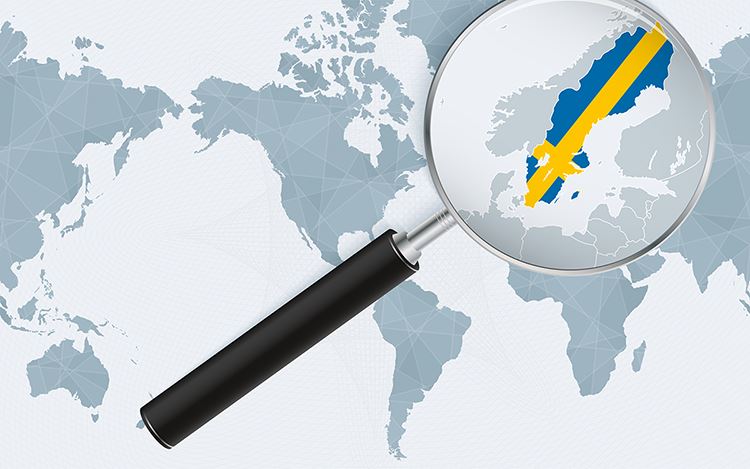Varukorg Minimera varukorgen
| SEK SEK EUR EUR |
| Rabatt | - EUR | - SEK |
| Summa | EUR | SEK |
| Frakt | EUR | SEK |
| Moms | EUR | SEK |
| Totalt | EUR | SEK |
Varukorg Minimera varukorgen
| SEK SEK EUR EUR |
| Rabatt | - EUR | - SEK |
| Summa | EUR | SEK |
| Frakt | EUR | SEK |
| Moms | EUR | SEK |
| Totalt | EUR | SEK |
Den 7 december anordnar den nationella kommittén för geodata ett öppet seminarium Standards in Action, där du har möjlighet att lyssna till de främsta experterna på geodata. Evenemanget hålls på engelska och du får inblick i hur standarder tillämpas i olika sammanhang och världen över. Seminariet är kostnadsfritt och öppet för alla.

Mötet är hybrid och hålls på engelska.
Fysiskt:
Anmäl dig via bokningsknappen här bredvid.
Välkommen till Svenska Institutet för Standarder, Solnavägen 1E / Torsplan, Stockholm.
Digitalt:
Länk digitalt mötesanmälan:
https://iso.zoom.us/meeting/register/tJUkduygrjstEtwbQcTNEpusaPxAhlYaUnnw
Vill du veta mer eller engagera dig i några av de pågående arbeten inom geografisk information så är du välkommen att kontakta Fredrik Stenberg på fredrik.stenberg@sis.se.
09.30 - 09.35 Welcome - Peter Parslow, ISO/TC 211 – Chair, Simon Vrečar- ISO/TC 211/AG 1 – Convenor, Allan Jamieson, ISO/TC 211/AG 1 - Convenor
Keynote
09.35 - 10.15 The use of a standardised framework in the digitalisation of the planning and building process:
The Swedish mapping, cadastral and land registration authority has a government assignment to establish a digital infrastructure for making standardized datasets available for all stakeholders in the urban planning and building process.
The implemented solution builds on distinct roles in an infrastructure that is built on open standards and open data. To achieve this, the information is designed to meet demands from regulations in the Swedish law, requirements from users, and must comply with the national information architecture framework for Geodata. The solution comes from standards and creates standards. - Malin Klintborg, Lantmäteriet (the Swedish mapping, cadastral and land registration authority)
Morning Session
10.15 - 10.35 Platform for data exchange at the Swedish Transport Administration:
- Data exchange platform at the Swedish Transport Administration, what types of data and what business scenarios it handles.
- How the platform implements a Digital integration Hub with access for both internal and external users in a secure way. - Lars Flodman, Swedish Transport Administration, Trafikverket
10.35 - 10.55 DGIWG reference architecture - TBD
Break
11.10 - 11.30 Function of the new quality standard 19157-1 and future Quality Measure register 19157-3:
Highlighting news in the Quality standard 19157 and theories of how quality evaluation act in cooperation with quality requirements in data product specification and reporting as metadata. - Torsten Svärd, Lantmäteriet (the Swedish mapping, cadastral and land registration authority)
11.30 - 11.50 Geocell Reinforcement Resource:
The resource is able, in the event of large-scale crisis, to produce customized maps in the field when the municipalities and regions do not have sufficient resources. - Caroline Lindhe, Lantmäteriet (the Swedish mapping, cadastral and land registration authority)
11.50 - 12.10 What is happening in the LADM revision - Chris Body, Australia
12.10 - 13.10 LUNCH BREAK
Afternoon Session
13.10 - 13.30 Why conformance to ISO 19160-2, Addressing - Part 2: Assigning and maintaining addresses for objects in the physical world, makes sense and how to prove conformance - Serena Coetzee, Department of Geography, Geoinformatics and Meteorology, South Africa
13.30 - 13.50 Collaboration between GIS-ITS and and the challenges in the work being done with the work in JWG 11 and the PWI 5974 - Trond Hovland, ITS Norway and Jonathan Harrod Booth, Consultant (ITS/Highways Systems)
13.50 - 14.10 UML models in action at the Danish Agency for Data Supply and Infrastructure:
The Danish Agency for Data Supply and Infrastructure applies a model-driven approach to its data management, that is, development regarding a data set is based on the logical data model for that data set. This model-driven approach is based on the practices standardized in the 19100 series of standards. It is supported by tools that allow the automatic generation of documentation of the logical data models and the automatic generation of physical schemas for storage and distribution of data sets. This presentation will present how the approach, the tools and their outputs are used in practice. - Heidi Vanparys, The Danish Agency for Data Supply and Infrastructure
Break
14.25 - 14.45 Intersection between geographic information and Smart Cities TBD
14.45 - 15.05 OGC APIs for Tiles and Maps:
Hear about the new “OGC API – Tiles” Standard and the emerging work with extending it.
The soon to be “OGC API – Maps”.
A summary of the important OGC plans for deprecation of the older web service Standards (such as Web Map Service and Web Map Tile Service). - Scott Simmons, Open Geospatial Consortium (OGC)
15.05 - 15.25 GeoE3 – Geospatially Enabled Ecosystem for Europe:
GeoE3 provides dynamic integration of data sets and services (e.g., meteorological, or statistical data) with geospatial features from existing national geospatial data platforms (e.g., building data or road network data) using modern geospatial API’s (e.g., ISO 19168-1, OGC API Coverages, OGC API EDR, etc.). GeoE3 develops fundamental services to better serve the European citizen by enhanced availability, interoperability, and integration of services. - Jari Reini, National Land Survey of Finland
15.25 - 15.30 Summary and end - Peter Parslow, ISO/TC 211 - Chair Simon Vrečar- ISO/TC 211/AG 1 – Convenor and Allan Jamieson, ISO/TC 211/AG 1 - Convenor
Telefon: 08-555 522 00
E-post: utbildning@sis.se